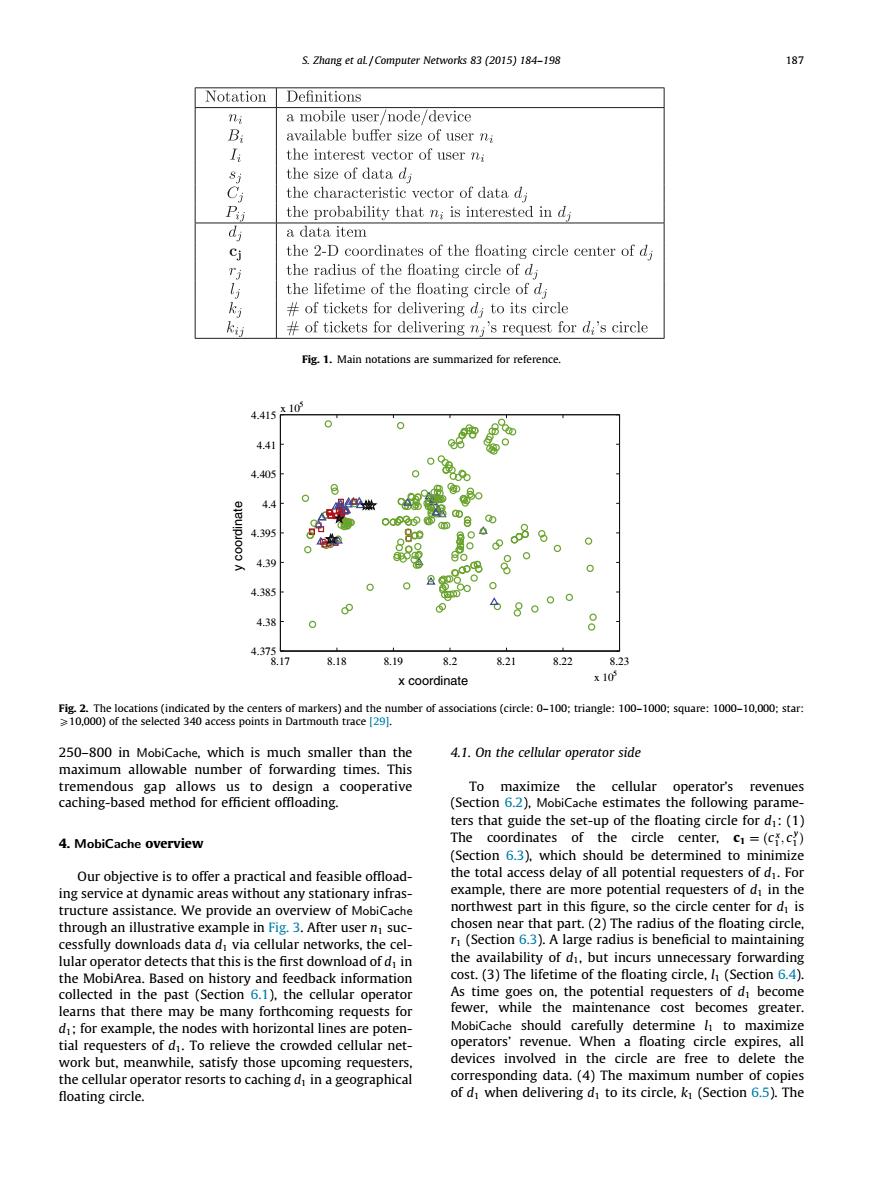正在加载图片...

S.Zhang et aL /Computer Networks 83 (2015)184-198 187 Notation Definitions n a mobile user/node/device B available buffer size of user n L the interest vector of user ni the size of data d, the characteristic vector of data di P the probability that n;is interested in d, a data item cj the 2-D coordinates of the floating circle center of d; i the radius of the floating circle of d the lifetime of the floating circle of di of tickets for delivering di to its circle k of tickets for delivering n,'s request for di's circle Fig.1.Main notations are summarized for reference 441510 4.41 4.405 0 。89 4.4 0039 0 4.395 80 ● 4.39 6 0 4.385 438 8 4.37 .17 8.18 8.19 8.2 8.21 8.22 8.23 x coordinate x10 Fig.2.The locations(indicated by the centers of markers)and the number of associations(circle:0-100:triangle:100-1000:square:1000-10.000:star: 10,000)of the selected 340 access points in Dartmouth trace [29]. 250-800 in MobiCache,which is much smaller than the 4.1.On the cellular operator side maximum allowable number of forwarding times.This tremendous gap allows us to design a cooperative To maximize the cellular operator's revenues caching-based method for efficient offloading. (Section 6.2),MobiCache estimates the following parame- ters that guide the set-up of the floating circle for d:(1) 4.MobiCache overview The coordinates of the circle center.c1=(c.c) (Section 6.3).which should be determined to minimize Our objective is to offer a practical and feasible offload- the total access delay of all potential requesters of d.For ing service at dynamic areas without any stationary infras- example,there are more potential requesters of d in the tructure assistance.We provide an overview of MobiCache northwest part in this figure,so the circle center for d is through an illustrative example in Fig.3.After user n suc- chosen near that part.(2)The radius of the floating circle, cessfully downloads data d via cellular networks,the cel- r(Section 6.3).A large radius is beneficial to maintaining lular operator detects that this is the first download of d in the availability of d,but incurs unnecessary forwarding the MobiArea.Based on history and feedback information cost.(3)The lifetime of the floating circle,h(Section 6.4). collected in the past (Section 6.1).the cellular operator As time goes on,the potential requesters of di become learns that there may be many forthcoming requests for fewer,while the maintenance cost becomes greater. d:for example,the nodes with horizontal lines are poten- MobiCache should carefully determine h to maximize tial requesters of d.To relieve the crowded cellular net- operators'revenue.When a floating circle expires,all work but,meanwhile,satisfy those upcoming requesters, devices involved in the circle are free to delete the the cellular operator resorts to caching d in a geographical corresponding data.(4)The maximum number of copies floating circle. of d when delivering d to its circle,k(Section 6.5).The250–800 in MobiCache, which is much smaller than the maximum allowable number of forwarding times. This tremendous gap allows us to design a cooperative caching-based method for efficient offloading. 4. MobiCache overview Our objective is to offer a practical and feasible offloading service at dynamic areas without any stationary infrastructure assistance. We provide an overview of MobiCache through an illustrative example in Fig. 3. After user n1 successfully downloads data d1 via cellular networks, the cellular operator detects that this is the first download of d1 in the MobiArea. Based on history and feedback information collected in the past (Section 6.1), the cellular operator learns that there may be many forthcoming requests for d1; for example, the nodes with horizontal lines are potential requesters of d1. To relieve the crowded cellular network but, meanwhile, satisfy those upcoming requesters, the cellular operator resorts to caching d1 in a geographical floating circle. 4.1. On the cellular operator side To maximize the cellular operator’s revenues (Section 6.2), MobiCache estimates the following parameters that guide the set-up of the floating circle for d1: (1) The coordinates of the circle center, c1 ¼ ðc x 1 ; c y 1 Þ (Section 6.3), which should be determined to minimize the total access delay of all potential requesters of d1. For example, there are more potential requesters of d1 in the northwest part in this figure, so the circle center for d1 is chosen near that part. (2) The radius of the floating circle, r1 (Section 6.3). A large radius is beneficial to maintaining the availability of d1, but incurs unnecessary forwarding cost. (3) The lifetime of the floating circle, l1 (Section 6.4). As time goes on, the potential requesters of d1 become fewer, while the maintenance cost becomes greater. MobiCache should carefully determine l1 to maximize operators’ revenue. When a floating circle expires, all devices involved in the circle are free to delete the corresponding data. (4) The maximum number of copies of d1 when delivering d1 to its circle, k1 (Section 6.5). The Fig. 1. Main notations are summarized for reference. 8.17 8.18 8.19 8.2 8.21 8.22 8.23 x 105 4.375 4.38 4.385 4.39 4.395 4.4 4.405 4.41 4.415 x 105 x coordinate y coordinate Fig. 2. The locations (indicated by the centers of markers) and the number of associations (circle: 0–100; triangle: 100–1000; square: 1000–10,000; star: P10,000) of the selected 340 access points in Dartmouth trace [29]. S. Zhang et al. / Computer Networks 83 (2015) 184–198 187